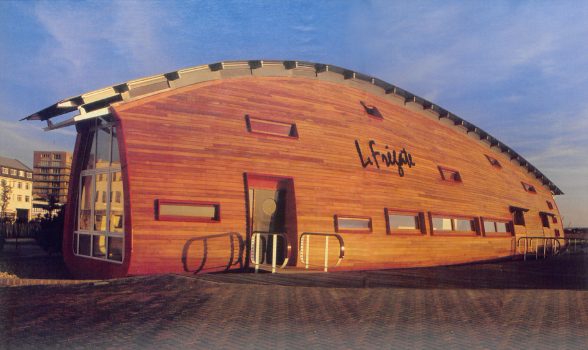This website uses cookies
This website uses cookies to enable it to function properly and to analyse how the website is used. Please click 'Close' to accept and continue using the website.



Image: The Architects Journal, 1997
C20 is delighted to learn that our application to list designed by Alsop and Störmer’s La Frégate café (1997) has been successful – Jersey Heritage confirming a Grade II designation this week. It is the first building by former RIBA Stirling Prize winner Will Alsop to be listed, and we believe it to now be the youngest listed building in the British Isles – overtaking James Stirling’s No.1 Poultry in the City of London (1994-98), which was recognised at Grade II* in 2016 following another successful C20 campaign.
The Society applied to list the cafe building in January 2022, after plans emerged from the Jersey Development Company to redevelop the Southwest waterfront area of St. Helier, involving a reprofiling of the sea wall flood defences and promenade area, where La Frégate café is sited. While the developer declined to comment, sources indicated the proposals would likely see the demolition of the café, with no plans to explore the feasibility of relocating the structure.

Image: The Architects Journal, 1997
La Frégate was intended to act as a catalyst for new, high-quality development on the waterfront. Supported on 24 stout concrete columns, the café’s ‘hull’ comprises a steel primary structure incorporating fabricated curved steel ‘ribs’ and a secondary carcassing of timber. The outer cladding is in Western red cedar shiplap boarding and its sleek form was reportedly tested in British Aerospace’s wind tunnel at Bath at model stage, to see how it would cope in its exposed coastal location.
The timber cladding is punctured by variously-sized rectangular windows and serving hatches – reminiscent of gun-ports – with entry via gullwing doors in the sides and glazed entrances at the ‘bow’ and ‘stern’ of the structure. Both the building’s exterior, its interior spaces and finishes are remarkably well preserved, with very few alterations having taken place since 1997.

Image: Mappio
While it initially met with a hostile reaction from locals – earning unflattering nicknames like the ‘pregnant armadillo and ‘beached whale’ – attitudes have softened somewhat over the past 25 years, gradually earning La Frégate the status of a beloved, if unconventional, island landmark.
It was later exhibited at the Sao Paolo International Architecture Biennale, while the Independent newspaper declared the building ‘had put Jersey on the international design map for the first time’. In the wake of Alsop’s death in 2018, the Jersey Evening Post described it as a ‘A legacy to be proud of’, stating that ‘The bold design of La Frégate still stands out from the majority of bland, conventional building design in Jersey.’
In his hastily sketched original concept, Alsop had suggested its curving form was inspired by a large fish. It later came to be interpreted as an upturned ship hull – appropriate given the local area’s historic shipbuilding industry, and the fact that timber hulled boats had once been constructed on the same site. Parallels could also be drawn to the coastal tradition of repurposing upturned hulls for buildings, such as the boat sheds of Lindisfarne and the boat homes of Équihen-Plage.
As a small-scale experimental structure, La Frégate can be mentioned alongside the likes of James Stirling’s Biennale bookshop (1991), Michael Hopkins and Partners’ Buckingham Palace ticket office (1995) and Alsop & Stormer’s own Visitor Centre at Cardiff Bay (1991), as well as Piers Gough’s Notting Hill flower stall (1993).
C20 Director Catherine Croft commented:
C20 is thrilled that our application to list La Frégate has been successful, and we look forward to working with the Jersey Government, Jersey Heritage and the developers to secure the future of the café within any new scheme for the St Helier waterfront.
Alsop and Störmer’s La Frégate (built 1997) is a fun, imaginative design, that fits within a rich tradition of playful seaside structures. Yet it’s also of outstanding architectural and historic significance and richly deserves this recognition – something Jersey residents should rightly be proud of!
Meanwhile, Alsop’s former partner Jan Störmer, speaking with the AJ, believed the now listed cafe could feasibly be relocated within any new development for the waterfront area:
‘The sculptural idea of the design is that of stranded “ark”, which of course can be carried on with next flood – so the location is not so important. Certainly, I can speak for my late friend and partner Will Alsop, and myself, that we hope that La Frégate will find another place on the beautiful island of Jersey.’

Become a C20 member today and help save our modern design heritage.